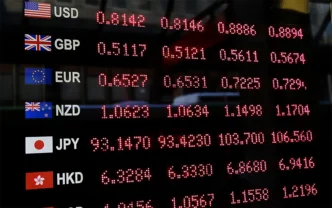The U.S. economy may have avoided a recession in 2025, but beneath the surface, a troubling divergence is widening. According to a recent report from Apollo Global Management, the same “K-shaped” dynamic that has defined the post-pandemic economy—where the wealthy surge ahead while others fall behind—is now deeply embedded in the S&P 500 itself.
The firm’s analysis reveals a striking pattern: a handful of mega-cap technology and energy companies are driving nearly all of the stock market’s gains, while a vast majority of smaller or more traditional firms lag far behind. The result, Apollo says, is a K-shaped stock market that mirrors the nation’s broader socioeconomic divide.
Winners Soar, the Rest Struggle
Apollo’s data highlights that as of late 2025, just 10 companies account for more than 60% of the S&P 500’s year-to-date returns—a concentration not seen since the late 1990s tech boom. These “super-performers” include AI-focused giants, semiconductor manufacturers, and energy firms benefiting from the explosive growth in data infrastructure and green transition spending.
“The market’s performance looks strong on paper, but under the surface, it’s incredibly uneven,” said Torsten Sløk, chief economist at Apollo. “What we’re witnessing is not broad-based prosperity—it’s a story of a few dominant winners and a long tail of underperformers.”
By contrast, sectors tied to consumer goods, real estate, and traditional retail have stagnated or declined, weighed down by higher interest rates, cooling demand, and shifting consumption patterns.
A Mirror of the Broader Economy
This financial split reflects a deeper K-shaped economic recovery, in which high-income households and corporations tied to financial assets have thrived, while wage earners and small businesses face persistent strain. The top 10% of U.S. households—those most exposed to equities—have seen their wealth grow at record pace, driven by the booming stock market.
Meanwhile, middle- and lower-income households, whose wealth is more dependent on wages and savings rather than capital markets, have struggled to keep up with inflation and rising costs.
“The same forces driving inequality in the economy are now visible in the market itself,” Sløk noted. “We have an S&P 500 that’s effectively split into two economies—one hyper-profitable and asset-driven, and another struggling with cost pressures and slowing demand.”
AI, Energy, and the Concentration of Wealth
Apollo’s report points to artificial intelligence and energy transformation as key drivers of market concentration. The surge in demand for AI infrastructure—data centers, semiconductors, and high-performance computing—has propelled a handful of firms to trillion-dollar valuations.
At the same time, energy producers and technology-adjacent utilities are benefiting from the global race to power AI systems, leading to a “new energy-industrial complex” that further consolidates corporate power and profitability.
“It’s no coincidence that both the AI and energy sectors are at the top of the K,” said Lisa Shalett, chief investment officer at Morgan Stanley Wealth Management, commenting on Apollo’s findings. “These are industries with massive capital requirements and deep barriers to entry. That naturally concentrates wealth and market dominance.”
The Downside: Fragility and Risk
While investors have celebrated record-breaking market performance in 2025—with the S&P 500 trading near 5,900 points—Apollo warns that such concentration carries systemic risks. A correction among a few key stocks could have an outsized impact on market valuations and investor sentiment.
“When only a small group of stocks drives the market, volatility risk becomes asymmetric,” Apollo’s report cautions. “If one or two leaders falter, it can ripple through the entire index.”
The dynamic also distorts broader economic indicators: corporate profits and productivity appear strong overall, but the underlying data show that profits are clustered in fewer firms, leaving the majority of businesses struggling to grow.
Wealth and Market Exposure: The Root of the Divide
Part of the growing gap between rich and average Americans, Apollo notes, can be traced directly to differences in market exposure. Households in the top income quintile hold nearly 90% of U.S. equity wealth, according to Federal Reserve data. Their fortunes have soared alongside the stock market’s rally, while those without substantial investments have seen limited benefit.
“For many households, the stock market has become the primary driver of wealth,” said Dr. Michelle Byrd, an economist at NYU Stern. “But because ownership is so concentrated, the gains amplify inequality rather than reduce it.”
As a result, the divide between financial asset holders and wage earners continues to widen—a dynamic economists fear could erode consumer confidence and social cohesion over time.
Policy and Market Implications
Apollo’s findings carry implications for both policymakers and investors. For policymakers, the report underscores the need to broaden access to capital markets and address structural inequality through education, investment, and wage growth. For investors, it raises the question of whether today’s market resembles the late-stage concentration of previous bull cycles—such as the dot-com era.
“We’re in a moment that feels euphoric, but also precarious,” said Shalett. “When growth is concentrated in too few names, it’s a signal to diversify—not to chase momentum.”
Some institutional investors are already repositioning portfolios to hedge against market concentration risk, favoring value stocks, mid-caps, and international equities as potential counterweights.
A Divided Future
The “K-shaped” S&P 500 captures a paradox at the heart of the modern American economy: immense innovation and prosperity for a select few, and stagnation for many others. While AI and energy-driven growth may define the next decade, the challenge will be ensuring that the benefits extend beyond corporate balance sheets to reach workers and consumers.
“The stock market is thriving—but not everyone is invited to the party,” said Byrd. “Until that changes, both the economy and society will continue to move on two very different tracks.”
Apollo’s warning paints a vivid picture of an economy—and a stock market—defined by divergence. As the S&P 500 soars to new highs, its uneven structure serves as a mirror for America’s broader inequalities, raising the question of how sustainable this form of prosperity can truly be.














